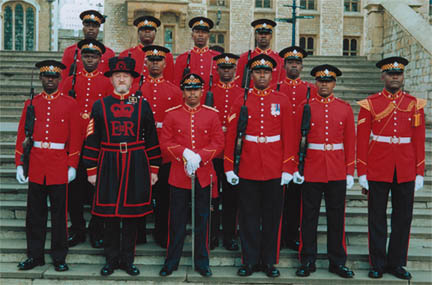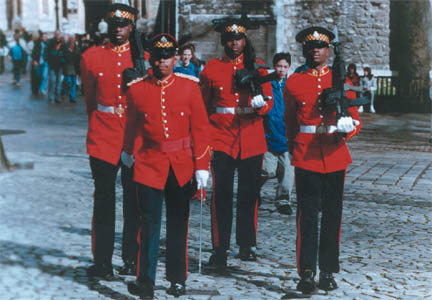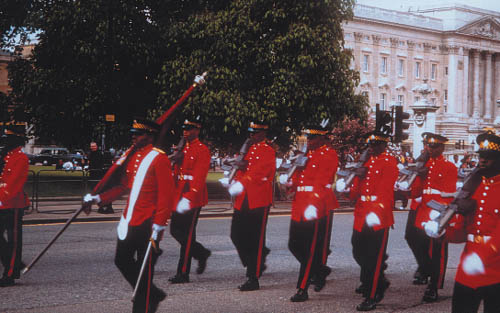|
|||||||||||||||||||||||||||||||
| Home > Info Centre > Publications > Alert 2000 > Royal Guards | |||||||||||||||||||||||||||||||
|
Our experience whilst conducting public duty in the UK earlier this year is best characterized as an honour replete with humility and pride. This honour was conferred upon the officers and men primarily of Charlie Company, 2JR, when from the 03rd to the 16th of April, 1999 they executed in a fine manner, their duty as the Queen’s and Windsor Castle Guards. The military ethos and tradition of the Jamaica Defence Force are due to our colonial heritage. This experience dominates Jamaica’s history and has given our military its inclination to spectacle and pomp. The Queen’s Guard Thus it was with honour, pride, and a sense of tradition, that those JDF soldiers stood on the square of Wellington Barracks, London, ready to march onto the forecourt of Buckingham Palace and into history. The mounting of the Queen’s Guard begins at Wellington Barracks, London, the headquarters of the Guards Brigade of the British Army. At this location, the men are formed up and an inspection is conducted by the Captain of the Guard . After the inspection, the Officers of the guard assume their positions and the Queen’s Colours are brought on to parade and handed to the Ensign by the Regimental Sergeant Major. At the precise time the Guard, comprising of three officers and twenty four other ranks, steps off and marches towards the forecourt of Buckingham Palace. Upon entering the Queen’s Gardens, dominated by the Queen Victoria Memorial, awareness increases that the eyes of the world are watching the body of superbly marching men . Through the gates and unto the graveled forecourt of the palace the Guard marches and maneuvers until they are face to face with the British Guard being relieved. With the halt, the music stops and the dueling begins. The old and new Guard Commanders each try to outdo the other’s words of command, much to the entertainment of spectators. Compliments are given and traditions observed, while Colours and Officers promenade the forecourt, as the new guards are mounted . The dismounted Guard marches off to Wellington Barracks while the New "C" Company Guard commences the public duty of guarding Her Majesty the Queen.
The Tower of London With all the press coverage surrounding the ceremony at the Buckingham Palace forecourt and at St James’ Palace, where our Queen’s Colours were on parade, it is perhaps easy to forget the accessory Tower of London Guard which is mounted without much fanfare, performing the 700-year-old, nightly Ceremony of the Keys . The Tower of London was constructed in 1066 AD as a fortress, to guard the mid reaches of the Thames River, and is officially known as "Her Majesty’s Royal Palace the Tower of London." It has evolved as a castle keep, prison, palace and finally showpiece museum, that today houses the Crown Jewels . It was once a prison of last residence and the execution site of infamous rogues, royal dissenters and traitors . These include Sir Walter Raleigh, Sir Thomas More, Mary Queen of Scots, Ann Boleyn and Charles 1. These famous prisoners were led to their deaths by the Yeoman Warders (Beefeaters) who now administer the Tower’s attractions. Today, the only creatures kept captive at the Tower are the ravens, whose departure is foretold to presage the fall of White Tower and the Monarchy. A select few officers and men were privileged to participate in this age old ritual, which had its origin in the nightly routine to secure the fortress against escape and intrusion. The ceremony commences at 9:30 each night, with the gaoler and his escort making rounds to each of the massive gates and securing each lock ritually. The Tower Guard, under the command of the officer, marches across the cobblestoned courtyard, their footsteps echoing through the night to halt in two ranks on the main steps leading from the moat. On approaching Traitor’s Gate where a lone ceremonial sentry stands, the gaoler and escort halt near a pool of light, cast by an ornate lamp. The sentry adopts the on guard position and issues a loud challenge "Halt who goes there?" to which the gaoler answers "The keys!" The sentry again challenges "Whose keys?" The gaoler answers "Queen Elizabeth II’s keys!" The sentry returns to the present arms and finally states "Pass Queen Elizabeth II’s keys. All is well!" The gaoler and escort pass the sentry and Traitor’s Gate, before coming to a halt on the landing below the Tower Guard. The Guard Commander orders the "present arms" as they approach. As the clock strikes 10 p.m., the bugler sounds the ‘Last Post’, which echoes throughout the complex. The final act is played out when the gaoler shouts "God save the Queen!" to which the guard responds "Amen!" The gaoler then ascends another set of steps, keys jangling in the still of the night, as the Guard Commander prepares to march off. A handful of specially invited guests witness this spectacle each night and are thrilled by the execution of drill, as well as the acoustic effect the Tower has on the words of command, bugle calls and the echo of marching feet. Following the ceremony, the Guard Commander and SNCO i/c Guard are traditionally invited to the exclusive Warder’s Club to tell tall tales and down tall pints, in the spirit of camaraderie and military kinship. In the meantime, the Tower’s courtyard falls silent, save for the hushed whispers of countless disembodied souls, at the end of yet another fine chapter in Jamaican and English history. The Windsor Castle Guard Windsor, located in the County of Berkshire, England, is the site of the world’s largest, continuously inhabited royal residence. Construction began in 1070 after the Norman Conquest of England by William the Conqueror in 1066. Built initially as one of nine protective fortifications of medieval London, the castle has evolved over time to function primarily as an official residence of the Queen. Today, Windsor Castle spreads over thirteen grand acres. Its layout reminds one of a walled town, famously described in legends such as Arthurian Camelot. Since the time of its construction, Windsor Castle has almost certainly required a Guard. English history is replete with examples of uprisings, rebellions and civil war. Windsor Castle has survived with the assistance of the Royal Guard. As such, when the Guard from 2JR lined up on April 3 1999, it was with an enormous sense of pride that they marched through the cobbled streets of Windsor to the admiration and encouragement of well-wishers, to begin a new chapter in our history. They were the first soldiers from the JDF to undertake public duty at a Royal residence. Other guards were conducted by JDF soldiers in 1969 and 1990 at Edinburgh castle.
It must be said that Her Majesty The Queen was officially in residence at Windsor throughout our public duties there. As the Queen is said to observe all such guard mounting ceremonies, no doubt the show put on by the succeeding guards in the Quadrangle of the State Apartments would have pleased Her Majesty From the Ceremonial Sentries performing their precise sentry drills and presenting of arms for any Royal personage, to the alert responsiveness of the Quick Reaction Force, the Royal guards mounted by 2JR served the Queen and country with pride and distinction, during this historic undertaking.
|
||||||||||||||||||||||||||||||
|
|
|||||||||||||||||||||||||||||||


 The
Queen’s Guard is comprised of two detachments. The Buckingham Palace detachment,
under the direction of the Subaltern of the Guard, stays at Buckingham Palace while the St
James’ Palace detachment, under the direction of the Captain of the Guard, marches to
St James’ Palace up the Mall. At St James’ Palace the officers of the
Queen’s Guard host and entertain their guests at lunch before settling into the more
mundane aspects of the 24 hour guard duty.
The
Queen’s Guard is comprised of two detachments. The Buckingham Palace detachment,
under the direction of the Subaltern of the Guard, stays at Buckingham Palace while the St
James’ Palace detachment, under the direction of the Captain of the Guard, marches to
St James’ Palace up the Mall. At St James’ Palace the officers of the
Queen’s Guard host and entertain their guests at lunch before settling into the more
mundane aspects of the 24 hour guard duty. On the bright
spring day that the guard from the 1st Bn, Coldstream Guards was relieved by us, the
courtyard echoed, as we matched them, command for command, and movement for movement over
the hour-long ceremony. After that initial 48 hour-guard, each guard mounted was of 24
hours duration, until the Coldstream Guards finally relieved us on April 16, 1999.
On the bright
spring day that the guard from the 1st Bn, Coldstream Guards was relieved by us, the
courtyard echoed, as we matched them, command for command, and movement for movement over
the hour-long ceremony. After that initial 48 hour-guard, each guard mounted was of 24
hours duration, until the Coldstream Guards finally relieved us on April 16, 1999.